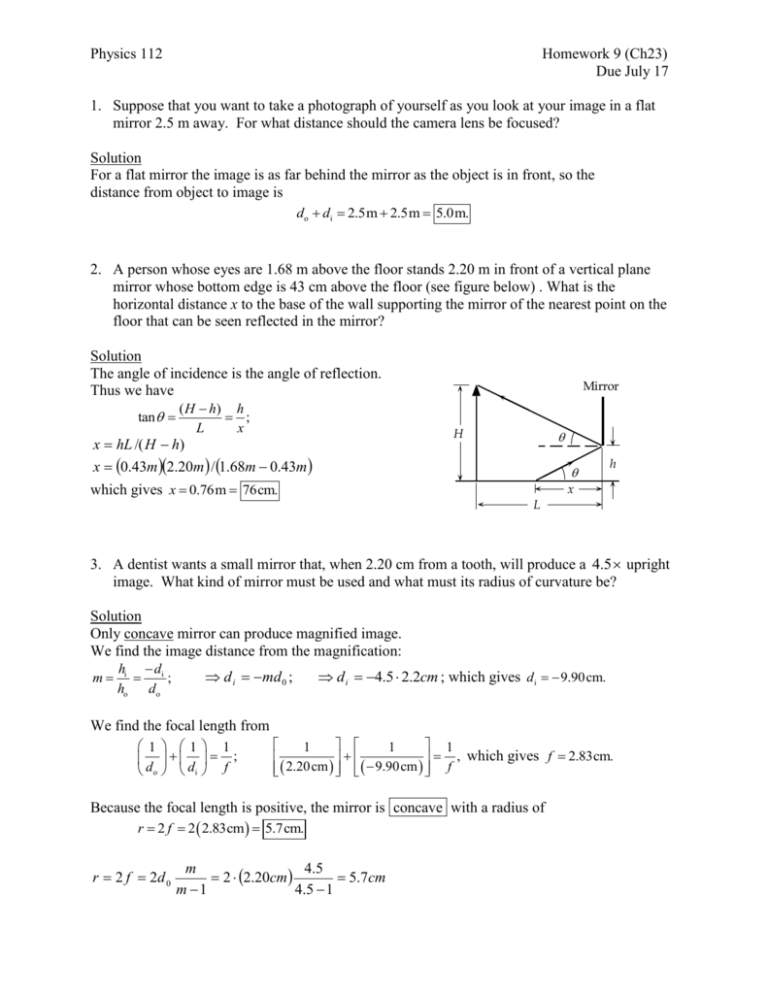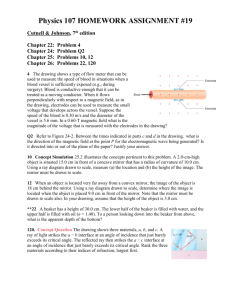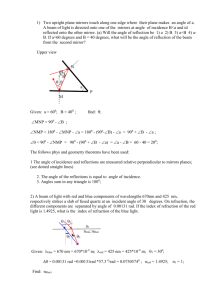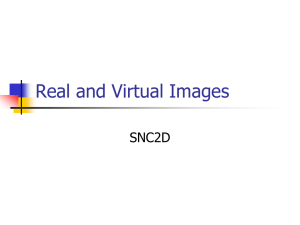Physics Homework: Mirrors & Refraction Problems
advertisement

Physics 112 Homework 9 (Ch23) Due July 17 1. Suppose that you want to take a photograph of yourself as you look at your image in a flat mirror 2.5 m away. For what distance should the camera lens be focused? Solution For a flat mirror the image is as far behind the mirror as the object is in front, so the distance from object to image is do di 2.5m 2.5m 5.0m. 2. A person whose eyes are 1.68 m above the floor stands 2.20 m in front of a vertical plane mirror whose bottom edge is 43 cm above the floor (see figure below) . What is the horizontal distance x to the base of the wall supporting the mirror of the nearest point on the floor that can be seen reflected in the mirror? Solution The angle of incidence is the angle of reflection. Thus we have tan ( H h) h ; L x Mirror H x hL /( H h) x 0.43m 2.20m / 1.68m 0.43m which gives x 0.76m 76cm. h x L 3. A dentist wants a small mirror that, when 2.20 cm from a tooth, will produce a 4.5 upright image. What kind of mirror must be used and what must its radius of curvature be? Solution Only concave mirror can produce magnified image. We find the image distance from the magnification: m hi di ; ho do d i md 0 ; d i 4.5 2.2cm ; which gives di 9.90cm. We find the focal length from 1 1 d o di 1 ; f 1 1 1 , which gives f 2.83cm. 2.20cm 9.90cm f Because the focal length is positive, the mirror is concave with a radius of r 2 f 2 2.83cm 5.7cm. r 2 f 2d 0 m 4.5 2 2.20cm 5.7cm m 1 4.5 1 Physics 112 Homework 9 (Ch23) Due July 17 4. The speed of light in a certain substance is 89% of its value in water. What is the index of refraction of this substance? Solution We find the index of refraction from c v ; n 0.89 vwater 0.89c c , 1.33 n which gives n 1.49. 5. A diver shines a flashlight upward from beneath the water at a 42.5° angle to the vertical. At what angle does the light leave the water? Solution We find the angle of refraction in the water from n1 sin 1 n2 sin 2 ; 1.33 sin 42.5 sin 2 , which gives 2 64.0. 6. In searching the bottom of a pool at night, a watchman shines a narrow beam of light from his flashlight, 1.3 m above the water level, onto the surface of the water at a point 2.7 m from the edge of the pool (see figure below). Where does the spot of light hit the bottom of the pool, measured from the wall beneath his foot, if the pool is 2.1 m deep? Solution We find the angle of incidence from the distances: tan1 L1 2.7 m 2.076, so 1 64.3. h1 1.3m For the refraction from air into water, we have nair sin 1 nwater sin 2 ; 1.00 sin 64.3 sin 2 , which gives 2 42.6. We find the horizontal distance from the edge of the pool from L2 L1 h2 tan 2 2.7m 2.1m tan 42.6 . m. h2 nair 1 h1 2 L1 L2 nwater Physics 112 Homework 9 (Ch23) Due July 17 7. A beam of light in air strikes a slab of glass (n 1.52) and is partially reflected and partially refracted. Find the angle of incidence if the angle of reflection is twice the angle of refraction. Solution The angle of reflection is equal to the angle of incidence: ref1 1 2 2 . For the refraction we have nair sin1 nglass sin 2 ; 1.00 sin 2 2 1.52 sin 2 . We use a trigonometric identity for the left-hand side: sin 2 2 2sin 2 cos 2 1.52 sin 2 , or cos 2 0.760, so 2 40.5. Thus the angle of incidence is 1 2 2 81.0. 8. Where should an object be placed in front of a concave mirror so that it produces an image at the same location as the object? (b) Is the image real or virtual? (c) Is the image inverted or upright? (d) What is the magnification of the image? Solution (a) With di d o , we locate the object from 1 1 1 ; d o di f 1 1 1 , which gives d o 2 f r. do do f The object should be placed at the center of curvature. (b) Because the image is in front of the mirror, d i 0, it is real. (c) The magnification is m di d o 1. do do Because the magnification is negative, the image is inverted. (d) As found in part (c), m 1. Physics 112 Homework 9 (Ch23) Due July 17 9. A 4.5-cm-tall object is placed 28 cm in front of a spherical mirror. It is desired to produce a virtual image that is upright and 3.5 cm tall. (a) What type of mirror should be used? (b) Where is the image located? (c) What is the focal length of the mirror? (d) What is the radius of curvature of the mirror? Solution (a) To produce a smaller image located behind the surface of the mirror requires a convex mirror. (b) We find the image distance from the magnification: m hi di ; ho do 3.5cm di , which gives 4.5cm 28cm di 21.8cm. As expected, di 0. The image is located 22 cm behind the surface. (c) We find the focal length from 1 1 1 ; d o di f 1 1 1 , which gives f 98cm. 28cm 21.8cm f (d) The radius of curvature is r 2 f 2 98cm 196cm.






